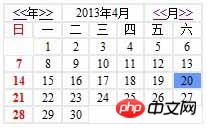Kalenderprogramm in PHP implementiert
In diesem Artikel wird hauptsächlich das in PHP implementierte Kalenderprogramm vorgestellt. Interessierte Freunde können darauf verweisen.
Die Details lauten wie folgt:
<?php
/*
* php 输出日历程序
*/
header("Content-type: text/html;charset=utf-8");
$year=(!isset($_GET['year'])||$_GET['year']=="")?date("Y"):$_GET['year'];
$month=(!isset($_GET['month'])||$_GET['month']=="")?date("n"):$_GET['month'];
$curUrl=$_SERVER['PHP_SELF'];
if($year<1971){
echo "出错!";
echo "<BR>";
echo "<a href=",$curUrl,">Back</a>";
exit();
}
?>
<table width="200" border="1" cellspacing="0" cellpadding="0" bordercolor="#E7E7E7" style="font-size:12px;" align="center">
<tr align="center"><td colspan="2">
<?php
//<-------当月份超出1至12时的处理;开始------->
if($month<1){
$month=12;
$year-=1;
}
if($month>12){
$month=1;
$year+=1;
}
//<-------当月份超出1至12时的处理;结束------->
//<---------上一年,下一年,上月,下月的连接处理及输出;开始--------->
echo "<a href=",$curUrl,"?year=".($year-1)."&month=".$month."><<</a>年<a href=",$curUrl,"?year=".($year+1)."&month=".$month.">>></a>";
?>
</td><td colspan="3"><?php echo $year."年".$month."月";?>
</td><td colspan="2">
<?php
echo "<a href=",$curUrl,"?month=".($month-1)."&year=".$year."><<</a>月<a href=",$curUrl,"?month=".($month+1)."&year=".$year.">>></a>";
//<--------上一年,下一年,上月,下月的连接处理及输出;结束--------->
?></td></tr>
<tr align=center><td><font color="red">日</font></td><td>一</td><td>二</td><td>三</td><td>四</td><td>五</td><td>六</td></tr><tr>
<?php
$d=date("d");
$FirstDay=date("w",mktime(0,0,0,$month,1,$year));//取得任何一个月的一号是星期几,用于计算一号是由表格的第几格开始
$bgtoday=date("d");
function font_color($month,$today,$year){//用于计算星期天的字体颜色
$sunday=date("w",mktime(0,0,0,$month,$today,$year));
if($sunday=="0"){
$FontColor="red";
}else{
$FontColor="black";
}
return $FontColor;
}
function bgcolor($month,$bgtoday,$today_i,$year){//用于计算当日的背景颜色
$show_today=date("d",mktime(0,0,0,$month,$today_i,$year));
$sys_today=date("d",mktime(0,0,0,$month,$bgtoday,$year));
if($show_today==$sys_today){
$bgcolor="bgcolor=#6699FF";
}else{
$bgcolor="";
}
return $bgcolor;
}
function font_style($month,$today,$year){//用于计算星期天的字体风格
$sunday=date("w",mktime(0,0,0,$month,$today,$year));
if($sunday=="0"){
$FontStyle="<strong>";
}else{
$FontStyle="";
}
return $FontStyle;
}
for($i=0;$i<=$FirstDay;$i++){//此for用于输出某个月的一号位置
for($i;$i<$FirstDay;$i++){
echo "<td align=center> </td>\n";
}
if($i==$FirstDay){
echo "<td align=center ".bgcolor($month,$bgtoday,1,$year)."><font color=".font_color($month,1,$year).">".font_style($month,1,$year)."1</font></td>\n";
if($FirstDay==6){//判断1号是否星期六
echo "</tr>";
}
}
}
$countMonth=date("t",mktime(0,0,0,$month,1,$year));//某月的总天数
for($i=2;$i<=$countMonth;$i++){//输出由1号定位,随后2号直至月尾的所有号数
echo "<td align=center ".bgcolor($month,$bgtoday,$i,$year)."><font color=".font_color($month,$i,$year).">".font_style($month,$i,$year)."$i</font></td>\n";
if(date("w",mktime(0,0,0,$month,$i,$year))==6){//判断该日是否星期六
echo "</tr>\n";
}
}
?>
</table>Der von PHP ausgegebene Kalendereffekt lautet wie folgt:

Zusammenfassung: Das Obige ist das Ich hoffe, dass der gesamte Inhalt dieses Artikels für das Studium aller hilfreich sein wird.
Verwandte Empfehlungen:
So generieren Sie QR-Code mit Logo in PHP
So implementieren Sie eine Model-Basisklasse basierend auf MySQL in PHP und Beispiele
Detaillierte Erläuterung der Methoden und Beispiele der PHP-Datei-Upload-Klasse
Das obige ist der detaillierte Inhalt vonKalenderprogramm in PHP implementiert. Für weitere Informationen folgen Sie bitte anderen verwandten Artikeln auf der PHP chinesischen Website!

Heiße KI -Werkzeuge

Undresser.AI Undress
KI-gestützte App zum Erstellen realistischer Aktfotos

AI Clothes Remover
Online-KI-Tool zum Entfernen von Kleidung aus Fotos.

Undress AI Tool
Ausziehbilder kostenlos

Clothoff.io
KI-Kleiderentferner

AI Hentai Generator
Erstellen Sie kostenlos Ai Hentai.

Heißer Artikel

Heiße Werkzeuge

Notepad++7.3.1
Einfach zu bedienender und kostenloser Code-Editor

SublimeText3 chinesische Version
Chinesische Version, sehr einfach zu bedienen

Senden Sie Studio 13.0.1
Leistungsstarke integrierte PHP-Entwicklungsumgebung

Dreamweaver CS6
Visuelle Webentwicklungstools

SublimeText3 Mac-Version
Codebearbeitungssoftware auf Gottesniveau (SublimeText3)

Heiße Themen
 1378
1378
 52
52
 Alipay PHP SDK -Übertragungsfehler: Wie kann das Problem von 'Class Signdata nicht deklarieren' gelöst werden?
Apr 01, 2025 am 07:21 AM
Alipay PHP SDK -Übertragungsfehler: Wie kann das Problem von 'Class Signdata nicht deklarieren' gelöst werden?
Apr 01, 2025 am 07:21 AM
Alipay PHP ...
 Erklären Sie JSON Web Tokens (JWT) und ihren Anwendungsfall in PHP -APIs.
Apr 05, 2025 am 12:04 AM
Erklären Sie JSON Web Tokens (JWT) und ihren Anwendungsfall in PHP -APIs.
Apr 05, 2025 am 12:04 AM
JWT ist ein offener Standard, der auf JSON basiert und zur sicheren Übertragung von Informationen zwischen Parteien verwendet wird, hauptsächlich für die Identitätsauthentifizierung und den Informationsaustausch. 1. JWT besteht aus drei Teilen: Header, Nutzlast und Signatur. 2. Das Arbeitsprinzip von JWT enthält drei Schritte: Generierung von JWT, Überprüfung von JWT und Parsingnayload. 3. Bei Verwendung von JWT zur Authentifizierung in PHP kann JWT generiert und überprüft werden, und die Funktionen und Berechtigungsinformationen der Benutzer können in die erweiterte Verwendung aufgenommen werden. 4. Häufige Fehler sind Signaturüberprüfungsfehler, Token -Ablauf und übergroße Nutzlast. Zu Debugging -Fähigkeiten gehört die Verwendung von Debugging -Tools und Protokollierung. 5. Leistungsoptimierung und Best Practices umfassen die Verwendung geeigneter Signaturalgorithmen, das Einstellen von Gültigkeitsperioden angemessen.
 Erklären Sie das Konzept der späten statischen Bindung in PHP.
Mar 21, 2025 pm 01:33 PM
Erklären Sie das Konzept der späten statischen Bindung in PHP.
Mar 21, 2025 pm 01:33 PM
In Artikel wird die in PHP 5.3 eingeführte LSB -Bindung (LSB) erörtert, die die Laufzeitauflösung der statischen Methode ermöglicht, um eine flexiblere Vererbung zu erfordern. Die praktischen Anwendungen und potenziellen Perfo von LSB
 Rahmensicherheitsmerkmale: Schutz vor Schwachstellen.
Mar 28, 2025 pm 05:11 PM
Rahmensicherheitsmerkmale: Schutz vor Schwachstellen.
Mar 28, 2025 pm 05:11 PM
In Artikel werden wichtige Sicherheitsfunktionen in Frameworks erörtert, um vor Schwachstellen zu schützen, einschließlich Eingabevalidierung, Authentifizierung und regelmäßigen Aktualisierungen.
 Wie sende ich eine Postanforderung mit JSON -Daten mithilfe der Curl -Bibliothek von PHP?
Apr 01, 2025 pm 03:12 PM
Wie sende ich eine Postanforderung mit JSON -Daten mithilfe der Curl -Bibliothek von PHP?
Apr 01, 2025 pm 03:12 PM
Senden von JSON -Daten mithilfe der Curl -Bibliothek von PHP in der PHP -Entwicklung müssen häufig mit externen APIs interagieren. Eine der gängigen Möglichkeiten besteht darin, die Curl Library zu verwenden, um Post � ...
 Anpassung/Erweiterung von Frameworks: So fügen Sie benutzerdefinierte Funktionen hinzu.
Mar 28, 2025 pm 05:12 PM
Anpassung/Erweiterung von Frameworks: So fügen Sie benutzerdefinierte Funktionen hinzu.
Mar 28, 2025 pm 05:12 PM
In dem Artikel werden Frameworks hinzugefügt, das sich auf das Verständnis der Architektur, das Identifizieren von Erweiterungspunkten und Best Practices für die Integration und Debuggierung hinzufügen.
 Beschreiben Sie die soliden Prinzipien und wie sie sich für die PHP -Entwicklung anwenden.
Apr 03, 2025 am 12:04 AM
Beschreiben Sie die soliden Prinzipien und wie sie sich für die PHP -Entwicklung anwenden.
Apr 03, 2025 am 12:04 AM
Die Anwendung des soliden Prinzips in der PHP -Entwicklung umfasst: 1. Prinzip der Einzelverantwortung (SRP): Jede Klasse ist nur für eine Funktion verantwortlich. 2. Open and Close Principle (OCP): Änderungen werden eher durch Erweiterung als durch Modifikation erreicht. 3.. Lischs Substitutionsprinzip (LSP): Unterklassen können Basisklassen ersetzen, ohne die Programmgenauigkeit zu beeinträchtigen. 4. Schnittstellen-Isolationsprinzip (ISP): Verwenden Sie feinkörnige Schnittstellen, um Abhängigkeiten und nicht verwendete Methoden zu vermeiden. 5. Abhängigkeitsinversionsprinzip (DIP): Hoch- und niedrige Module beruhen auf der Abstraktion und werden durch Abhängigkeitsinjektion implementiert.
 Wie funktioniert die Session -Entführung und wie können Sie es in PHP mildern?
Apr 06, 2025 am 12:02 AM
Wie funktioniert die Session -Entführung und wie können Sie es in PHP mildern?
Apr 06, 2025 am 12:02 AM
Die Hijacking der Sitzung kann in den folgenden Schritten erreicht werden: 1. Erhalten Sie die Sitzungs -ID, 2. Verwenden Sie die Sitzungs -ID, 3. Halten Sie die Sitzung aktiv. Zu den Methoden zur Verhinderung der Sitzung der Sitzung in PHP gehören: 1. Verwenden Sie die Funktion Session_regenerate_id (), um die Sitzungs -ID zu regenerieren. 2. Store -Sitzungsdaten über die Datenbank, 3. Stellen Sie sicher, dass alle Sitzungsdaten über HTTPS übertragen werden.




